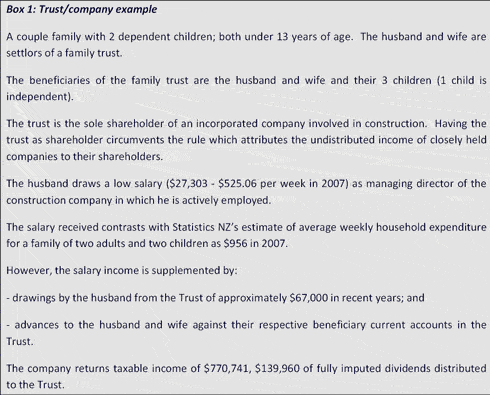Treasury explains how to receive Working for Families if you earn too much
18th Aug 09, 1:25pm
by
In one of its briefing papers to the Tax Working Group, Treasury outlined how taxpayers who are not part of the target group for Working for Families (WfF) are able to 'arrange their affairs' in order to be eligible to receive the tax credits. The paper noted that there were over 9,700 families with rental losses offsetting other income, who receive WfF tax credits. This is from pages 14-16 of the Treasury briefing paper titled 'Design of the Income Tax/Transfer System'. What is referred to as an 'EMTR' in the paper is an 'effective marginal tax rate':
There is also growing evidence that taxpayers that are not part of the target income group are receiving Working for Families tax credits by either:There are a number of ways in which income can be earned so as to avoid the higher EMTRs that would arise if the income were earned directly as personal income. Even if the top marginal tax were aligned with the company tax rate and the trustee tax rate (as in the 30:30:30 option), there are a number of ways the income could be earned which would avoid the higher EMTRs that arise when Working for Families (WFF) is abated that should be considered from a policy perspective:
- Reducing their "income" as defined for Working for Families tax credits purposes; and/or
- Converting income into forms that are not treated as "income" for Working for Families tax credits purposes.
There are, for example, over 9,700 families with rental losses offsetting other income, who receive Working for Families tax credits. The example on Box 1 shows how earning income well above the top tax rate threshold can be sheltered such that a family is still eligible for Working for Families tax credits.
- Income accumulating in companies is taxed at the company rate which is less than the EMTR which would arise if that income were earned directly by those on higher EMTRs.
- Income accumulating in trusts and distributions from trusts of amounts that have been previously taxed as trustee income are not counted as income for WFF purposes (following the income tax treatment). A common structure that can take advantage of this feature to avoid high EMTRs involving WFF credits is a trading company owned by a trust. The distributed company income is taxed as trustee income to the trustee with subsequent distributions of these amounts from the trust to the beneficiaries who may be claiming WFF credits. This means that substantial receipts by beneficiaries of trusts are not taken into account in determining their WFF entitlement.
- Instead of receiving taxable wages and salary there is an incentive for WFF recipients to maximise the fringe benefits they receive from their employers. These fringe benefits can be closely substitutable with cash, for example, the use of an employer's credit card. This risk is particularly high with closely held companies.
- Instead of investing in a normal bank account and receiving interest that is counted for WFF purposes, WFF recipients have an incentive to invest in cash PIEs (ie, PIE investments that are not locked in until retirement age) because distributions from PIEs are not taken into account in determining their WFF entitlement. Similar incentives can arise with other widely"held savings vehicles.
- Rental losses from investment properties (not amounting to a business) of WFF recipients are not added back in determining their WFF entitlement. This is inconsistent with the treatment of other losses which are added back.

 Here is the full Treasury briefing paper below.
Tax Working Group Briefing Paper
Here is the full Treasury briefing paper below.
Tax Working Group Briefing Paper

We welcome your comments below. If you are not already registered, please register to comment
Remember we welcome robust, respectful and insightful debate. We don't welcome abusive or defamatory comments and will de-register those repeatedly making such comments. Our current comment policy is here.